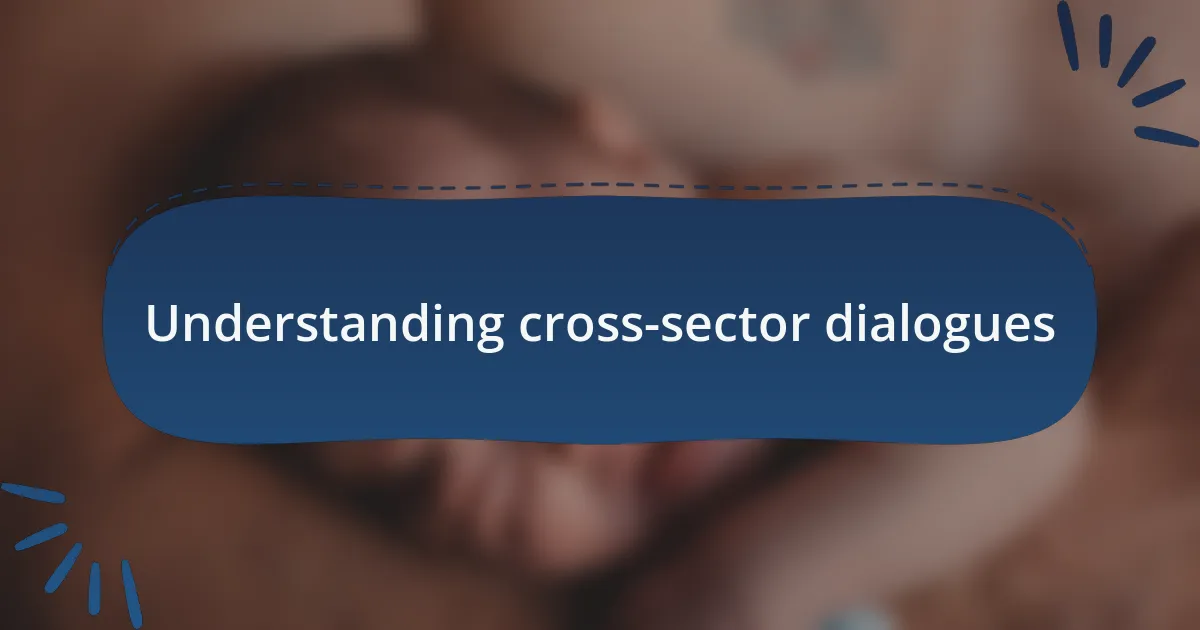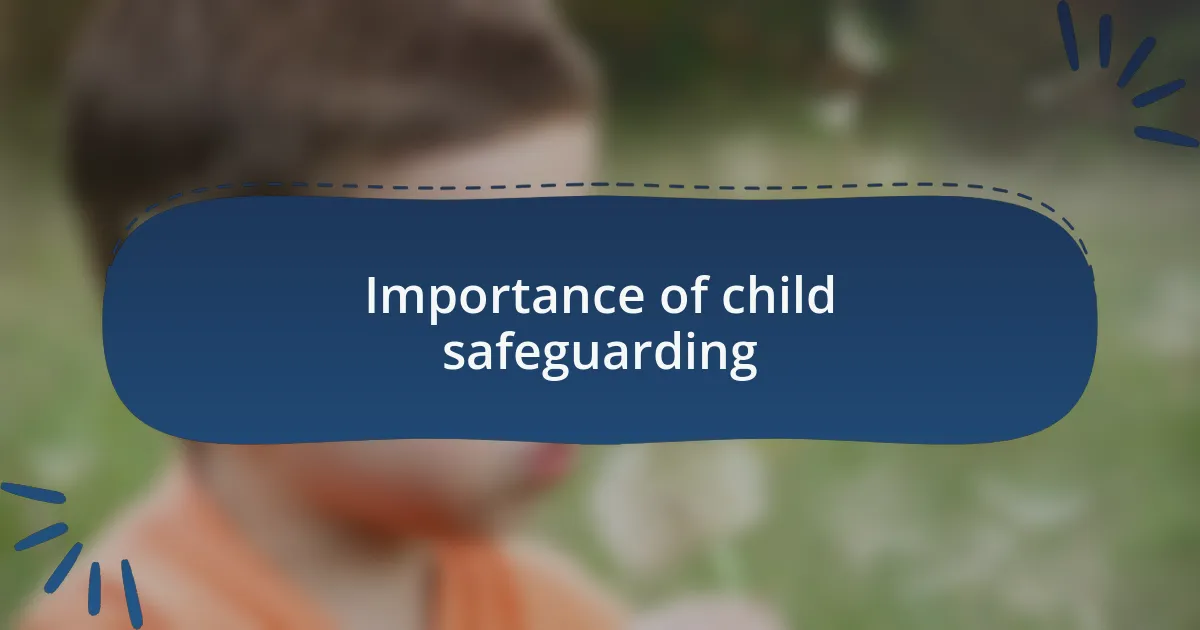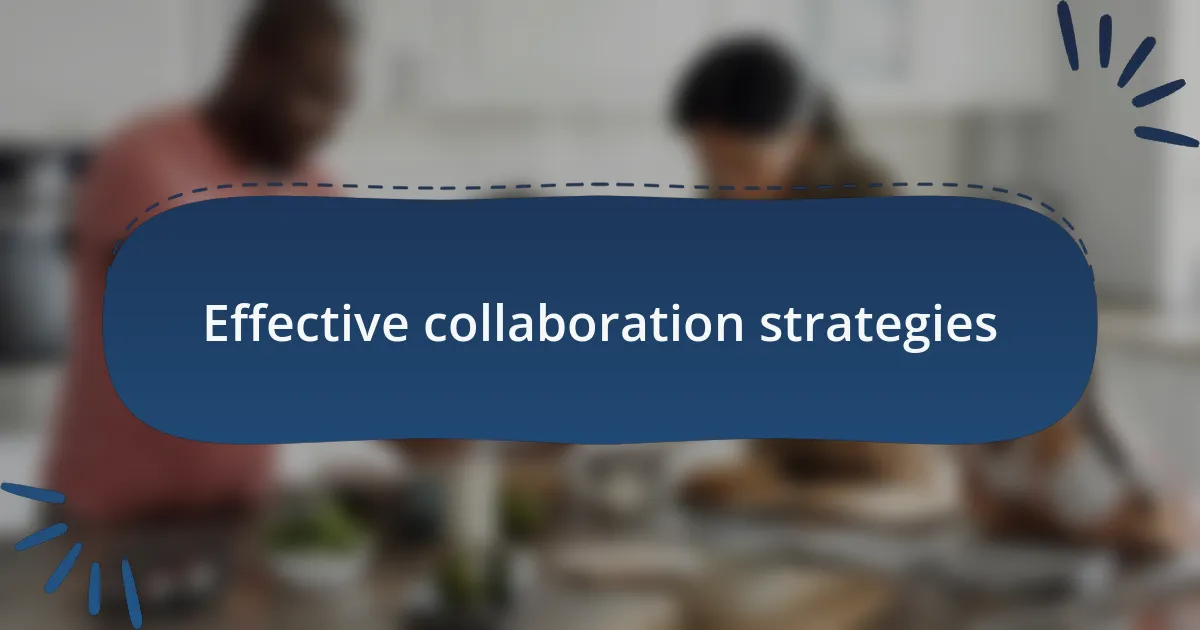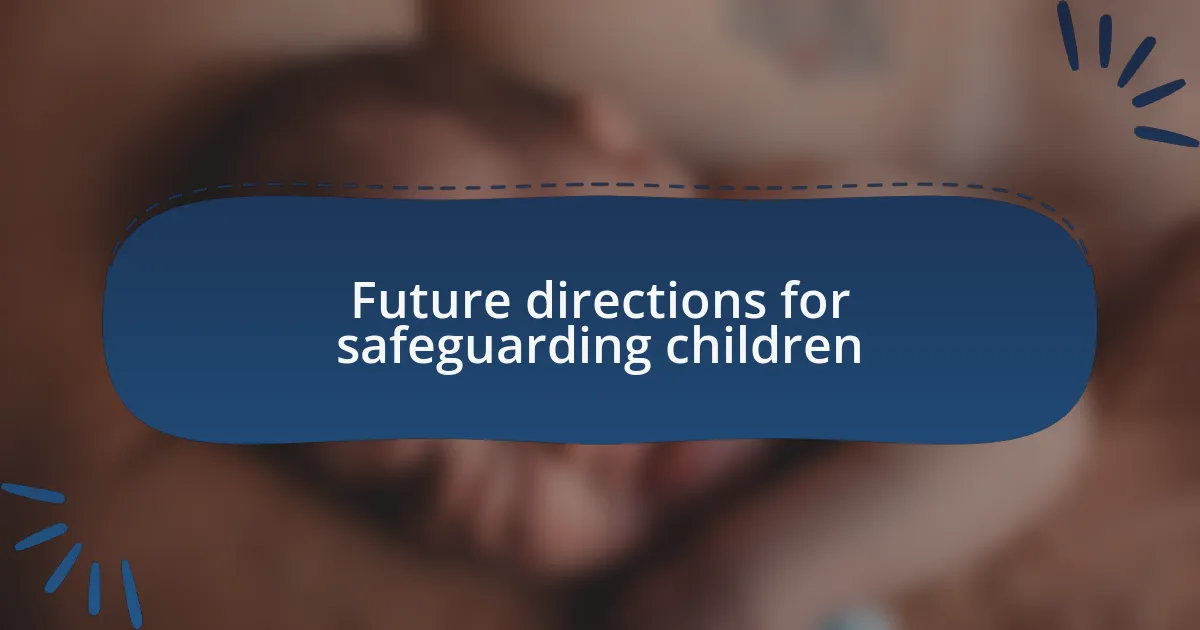Key takeaways:
- Cross-sector dialogues enhance understanding and collaboration among professionals from different fields, fostering innovative solutions for child safeguarding.
- Child safeguarding is a moral and legal obligation that requires proactive measures, awareness, and the empowerment of adults and children alike.
- Effective collaboration strategies include regular communication and joint training sessions among stakeholders, as well as engaging parents and communities in the safeguarding process.
- Future directions for safeguarding children involve leveraging technology, incorporating young people’s perspectives, and promoting community-centric models for proactive support.

Understanding cross-sector dialogues
Cross-sector dialogues are conversations that bring together different fields—such as education, health, and child welfare—to address common challenges. I’ve witnessed firsthand how these discussions can foster innovative solutions, especially when experts from diverse backgrounds share their perspectives. It’s fascinating to see how a social worker’s insight, when combined with a teacher’s experience, can create a richer understanding of a child’s needs.
Imagine sitting in a room filled with professionals from various sectors, each carrying a unique piece of the puzzle. It can be invigorating to listen to someone from a different industry explain how their strategies impact child safeguarding. How often do we consider the interconnectedness of our work? I find that these dialogues not only broaden our horizons but also deepen our commitment to protecting children by approaching issues from multiple angles.
Furthermore, my interactions in such spaces often remind me of the power of collaboration. For instance, during a recent forum, a healthcare worker shared how preventive health measures could reduce vulnerabilities for children in unsafe environments. It made me ponder: what if everyone involved prioritized not just their own agenda but also the collective goal of safeguarding children? These moments illustrate that understanding cross-sector dialogues is not just about conversation—it’s about building a community dedicated to making a difference.

Importance of child safeguarding
Child safeguarding is an essential moral and legal obligation that ensures children are protected from harm, neglect, and abuse. In my experience working with vulnerable families, I’ve seen the devastating effects when safeguards are absent. It’s heartbreaking to think about the potential lost when children are not provided a safe environment to grow and thrive.
Engaging in safeguarding measures can significantly affect children’s development and well-being. Once, I attended a community workshop where we discussed the importance of proactive measures. Hearing stories from parents about their struggles to keep their children safe reminded me of how critical our role is in prevention. We often underestimate the ripple effect of our efforts in safeguarding, but it’s crucial to recognize that every step taken can help create a more secure world for children.
Moreover, effective child safeguarding goes beyond mere policies; it is about fostering a culture of awareness and vigilance. I remember a project where we trained educators on recognizing signs of distress in children. It was enlightening to see their transformation from passive observers to active guardians. When we empower adults with knowledge and tools, we cultivate an environment that prioritizes children’s safety and can intervene before situations escalate. How often do we reflect on our influence in safeguarding the next generation?

Key principles of safeguarding children
Child safeguarding relies heavily on the principle of prevention. In my time working in community outreach, I was involved in creating awareness programs that focused on identifying risk factors. One experience stands out: we invited local parents to discuss what red flags they noticed in their children’s behavior. Their openness illuminated just how crucial it is to foster communication between families and safeguarding professionals. When parents feel empowered to share their concerns, we open a dialogue that can avert potential crises.
Another key principle is the necessity of multi-agency collaboration. I once participated in a roundtable with healthcare providers, educators, and social workers where we pooled resources to develop a joint safeguarding protocol. It was inspiring to witness how sharing information allowed us to take a more holistic approach to each child’s needs. This collaboration not only strengthens our collective response but also creates a safety net that encompasses various aspects of a child’s life. How often do we realize that safeguarding is not the sole responsibility of one entity but requires a united front?
Moreover, listening to the voices of children themselves is fundamental. In my experience, when I engaged children in dialogue about their safety, I was astonished by their insights. They often have the clearest perceptions of their surroundings. After facilitating a workshop, one child expressed a profound sense of empowerment, saying, “I want to tell others that it’s okay to speak up.” This reinforces the principle that safeguarding isn’t solely about protecting children but also about empowering them to advocate for their own rights. Don’t we owe it to them to ensure their perspectives shape our safeguarding policies?

Effective collaboration strategies
Effective collaboration strategies among different sectors can significantly enhance child safeguarding efforts. In my experience, establishing regular communication channels between various stakeholders—like schools, healthcare, and community organizations—can foster a culture of transparency and trust. I remember a specific initiative where we set up monthly meetings among different agencies. These gatherings became a platform for sharing updates and discussing challenges, which ultimately led to more coordinated responses to safeguarding issues.
Another strategy is to create joint training sessions for professionals across sectors. I once facilitated a workshop where social workers, teachers, and law enforcement officers came together to learn about the signs of abuse and neglect. The energy in the room was palpable; by sharing our expertise, we not only deepened our understanding but also built relationships that made it easier to collaborate in crises. How often do professionals operate in silos, unaware of the valuable insights their colleagues can provide?
Lastly, engaging parents and communities in the collaboration process is crucial. I recall a community forum where we invited parents to share their experiences with safeguarding. Their stories illuminated gaps in our approach and led to the creation of targeted outreach programs. When we actively involve the community, it transforms our strategies from theoretical to practical solutions that genuinely address the needs of children. Isn’t it time we recognize that the voices of those we serve can lead us to more effective safeguarding practices?

My experiences in policy dialogues
My experiences in policy dialogues have often highlighted the power of diverse perspectives. During a roundtable discussion that brought together child welfare advocates and law enforcement officials, I was struck by the differing views on how to approach trauma-informed care. Listening to one officer share how a child’s behavioral issues were often misinterpreted illuminated for me the need for deeper cross-training. Have you ever wondered how one conversation can change the course of an initiative?
There was a memorable occasion when I participated in a stakeholder meeting where parents were invited to voice their concerns. Their heartfelt stories about the lack of resources for at-risk youth were not just eye-opening; they felt deeply personal. It reminded me that every statistic has a face, and each narrative has the potential to reshape policies that protect children. Isn’t it fascinating how real-life experiences can drive home the urgency for change?
In another dialogue, we discussed integrating mental health services into existing welfare programs. My passion for this issue came from witnessing the ripple effects of unaddressed mental health needs in my community. As I watched colleagues grapple with how to make such integration a reality, I realized that practical examples from real cases would be vital. How can we create effective policies without grounding them in the challenges people actually face?

Lessons learned from cross-sector efforts
One significant lesson I’ve learned from cross-sector efforts is the importance of building trust between different stakeholders. I recall a workshop where educators and healthcare workers collaborated on supporting children with special needs. The initial tension was palpable, but as we shared stories about our experiences, barriers began to dissolve. Have you ever noticed how the willingness to listen fosters greater understanding?
Another insight revolves around the necessity of flexibility in policy frameworks. While attending a discussion on child protective services, it became clear that rigid guidelines often hinder adaptive responses to unique family situations. When one social worker shared an example of successfully tailoring interventions to fit individual needs, it became evident that surprising outcomes can emerge from a willingness to adapt. Isn’t it interesting how a flexible approach can lead to better results?
Finally, I’ve come to appreciate the power of continuous learning in cross-sector dialogues. During a collaboration focused on preventive measures against child abuse, I found myself reflecting on the value of feedback loops. Engaging various sectors in ongoing evaluations and revisions ensures that we don’t just create policies but also cultivate an environment where innovation thrives. Have you experienced the transformative impact of a commitment to learning and growth within a group?

Future directions for safeguarding children
Looking ahead, I believe that embracing technology will be a game changer for safeguarding children. In a recent meeting, I witnessed how digital platforms allowed different organizations to share vital data in real-time, enhancing response times to concerns about at-risk children. Can you imagine the impact of streamlining communication like that? The potential is huge when we leverage innovative tools to connect agencies more efficiently.
I’ve also pondered the significance of involving children and young people in the safeguarding dialogue. During a project, I spoke with several teenagers who expressed their views on safety and well-being. Their insights were eye-opening, showing me that young voices are often overlooked yet incredibly valuable in shaping relevant policies. Isn’t it crucial that we listen to those most affected by the systems we put in place?
Lastly, as I contemplate future approaches, the notion of community-centric models stands out to me. I’ve seen firsthand how local community groups can rally together to provide support and awareness for families. It makes me wonder: how can we incentivize these grassroot movements to take more proactive roles in child safeguarding? I firmly believe that by empowering communities, we can create a robust safety net that makes a real difference in children’s lives.